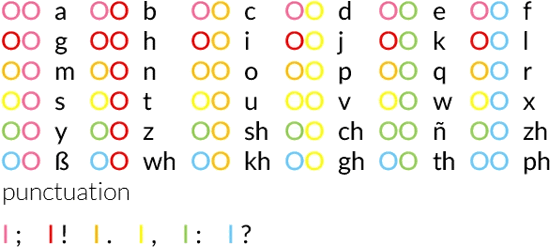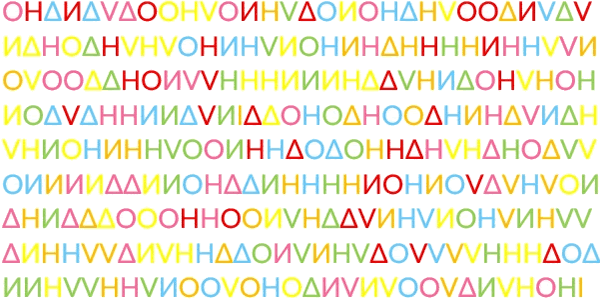The Simtex script is an elaborate ciphering script developed by Jeffrey Recinos around 2012. Simtex was very influenced and inspired by the Daukin alphabet. The name Simtex was inspired by Semtex, a type of sticky grenade, as the creator describes the script as "sticking together and exploding with color," as Simtex is based on 6 colors and is written with no spaces. Simtex was originally intended to be used for just English but has since been reworked to include Spanish; and, to a lesser extent, any language written in a non-accented Latin script.
First are the symbols used in Simtex:

These can be found on most standard fonts and the characters are Latin capital O, Latin capital H, Greek capital Δ (Delta), Latin capital V, Cyrillic capital И (I), and Latin capital I. (Font used for Simtex is Lato Medium)
There are 6 colors used in Simtex:

Simtex uses a combination of two of the above symbols to represent a letter known as a couplet. Which letter it represents depends also on the color used for each symbol:

The base is the graph of all possible color combinations for each couplet. Each color combination is also given a letter which can be moved around.

To begin, you first need a coding style. As Simtex is a very flexible script, there are four main ways to write in the simtex script:
d stands for the direction to move when using the couplet graph. cL stands for counting by letter, whereas cW stands for counting by word (explained below). f stands for flipping the couplets.
I'm going to choose the spracchigno style of coding to explain the usage of Simtex. I'm also going to use the word "word" as a sample. Now, using the couplet graph, one has to move to the adjacent cell corresponding with whatever direction to move in. One always has to start at OO when beginning on the first letter of the first word of the first sentence, but the direction is instructed as ø, meaning one doesn't move at all from OO. Now cL stands for counting by the letter in the alphabet. W is the 23rd letter in the English alphabet, so one has to move 23 spaces to the right from OO, resulting in the couplet
![]()
Since spracchigno also requires flipping of the couplets, the final couplet one should obtain is
![]()
Now using the base, the letter W contains the colors yellow and green (respectively). But VИ contains the instructions u2l2, signifying one has to shift the position of the letter W two spaces up and two spaces left. Moving two spaces up, one would get
![]()
And moving two cells to the left would yield
![]()
which is the final couplet and color used for the letter W.
Returning to the couplet graph; to find the next couplet to use, one has to move in the same directions used in shifting the colors to begin at the next couplet. Which means beginning from VИ, one has to shift two cells up and two cells left to start at the next couplet. Doing so, one should begin at the couplet
![]()
From here, one repeats the same process for finding the letter O as was for finding the letter W. As O is the 15th letter in the alphabet, one would move 15 spaces from HΔ, ending with ИΔ. Flip the couplets to get
![]()
Using the base, O is double orange. ΔИ contains the instructions u2r2, signifying one has to move two spaces up and two spaces right. Doing that, one should end up with the couplets
![]()
Repeating the process for R, one would move two spaces up and two spaces to the right. Moving up results in OИ and moving two right (looping to the other side of the graph) results in OH. Repeating all the processes, the final coding for "word" should be
![]()
As one letter can be represented by multiple couplets and color combinations, no one letter will most likely ever use the same couplet and color combination in a prominent word used across many sentences.
cW means counting by the number of letters in a particular word. So for "word", the amount of spaces to shift in the couplet graph will always be four, no matter which letter is being coded, resulting in the couplets
![]()
One last thing to point out: the extra letters sh, ch, ñ, zh, ß, wh, kh, gh, th, and ph are considered the 27th thru 36th letters of Simtex, respectively.

All human beings are born free and equal in dignity and rights. They are
endowed with reason and conscience and should act towards one another in
a spirit of brotherhood.
(Article 1 of the Universal Declaration of Human Rights)
If you have any questions about Simtex, you can contact Jeffrey at languo7@live.com
Gagrite, Naric, Simtex, Todocisian, Tolianem
Constructed scripts for: Ainu | Arabic | Chinese languages | Dutch | English | Hawaiian | Hungarian | Japanese | Korean | Lingala | Malay & Indonesian | Persian | Tagalog / Filipino | Russian | Sanskrit | Spanish | Taino | Turkish | Vietnamese | Welsh | Other natural languages | Colour-based scripts | Tactile scripts | Phonetic/universal scripts | Constructed scripts for constructed languages | Adaptations of existing alphabets | Fictional alphabets | Magical alphabets | A-Z index | How to submit a constructed script
[top]
You can support this site by Buying Me A Coffee, and if you like what you see on this page, you can use the buttons below to share it with people you know.

If you like this site and find it useful, you can support it by making a donation via PayPal or Patreon, or by contributing in other ways. Omniglot is how I make my living.
Note: all links on this site to Amazon.com, Amazon.co.uk
and Amazon.fr
are affiliate links. This means I earn a commission if you click on any of them and buy something. So by clicking on these links you can help to support this site.
[top]